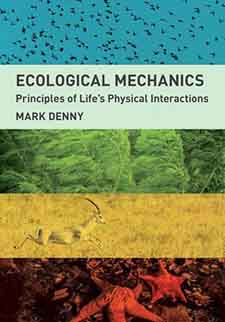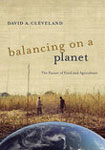Book Details

Ecological Mechanics : Principles of Life's Physical Interactions
Denny opens with a brief review of basic physics before introducing the fundamentals of diffusion, fluid mechanics, solid mechanics, and heat transfer, taking care to explain each in the context of living organisms. Why are corals of different shapes on different parts of a reef? How can geckos climb sheer walls? Why can birds and fish migrate farther than mammals? How do desert plants stay cool? The answers to these and a host of similar questions illustrate the principles of heat, mass, and momentum transport and set the stage for the book’s central topic—the application of these principles in ecology. Denny shows how variations in the environment—in both space and time—affect the performance of plants and animals. He introduces spectral analysis, a mathematical tool for quantifying the patterns in which environments vary, and uses it to analyze such subjects as the spread of invasive species. Synthesizing the book’s materials, the final chapters use ecological mechanics to predict the occurrence and consequences of extreme ecological events, explain the emergence of patterns in the distribution and abundance of organisms, and empower readers to explore further.
List of Tables
Acknowledgements
Chapter 1 ECOLOGICAL MECHANICS
An Introduction
Part I Basic Concepts
Chapter 2 BASIC PHYSICS AND MATH
Chapter 3 RESPONSE FUNCTIONS
Part II The Mechanics of Transport
Chapter 4 DIFFUSION
Random Motion and its Consequences
Chapter 5 AN INTRODUCTION TO FLUID MECHANICS
Chapter 6 BOUNDARY LAYERS I
Equilibrium Layers
Chapter 7 BOUNDARY LAYERS II
Dynamic Layers
Chapter 8 FLUID-DYNAMIC FORCES I
Introduction and Low-Reynolds-Number Flows
Chapter 9 FLUID-DYNAMIC FORCES II
High Reynolds Numbers
Chapter 10 LOCOMOTION
Chapter 11 THERMAL MECHANICS I
Introduction, Solar Heating, Convection,Metabolism, and Evaporation
Introduction, Solar Heating, Convection, Metabolism, and Evaporation
Chapter 12 THERMAL MECHANICS II
Stored Energy, Conduction, Long-Wave Radiation, and Synthesis
Part III Solid Mechanics
Chapter 13 BIOLOGICAL MATERIALS I
Materials Mechanics
Chapter 14 BIOLOGICAL MATERIALS IIThe Spectrum of Biological Materials
Chapter 15 FRACTURE MECHANICS AND FATIGUE
Chapter 16 ADHESION AND ADHESION RESISTANCE
Chapter 17 STATICS
Bending and Twisting
Chapter 18 DYNAMICS
The Mechanics of Oscillation
Part IV Ecological Mechanics
Chapter 19 ECOLOGICAL VARIATION AND ITS CONSEQUENCES
Chapter 20 SPECTRAL ANALYSIS
Quantifying Variation in Time and Space
Chapter 21 QUANTIFYING THE EFFECTS OF SCALE
Chapter 22 BIOLOGY OF EXTREMES
Chapter 23 PATTERN AND SELF-ORGANIZATION
Chapter 24 THOUGHTS AT THE END
References
Symbol Index
Author Index
Subject Index

FOREIGN ATTACHMENTS : THE POWER OF ETHNIC GROUPS IN THE MAKING OF AMERICAN FOREIGN POLICY

OUR ONCE AND FUTURE PLANET : RESTORING THE WORLD IN THE CLIMATE CHANGE CENTURY
Popular Picks on the Month















